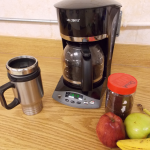Perk Up, Coffee Drinkers
In 2011, NSF International, an independent, not-for-profit organization, conducted a study with 22 families and analyzed 30 items in their homes. One item that disappointingly made NSF International’s list of the “Top Ten Germiest Places in the Home” was the coffee reservoir. This could be sad news for the approximately 239 million individuals, or 83 percent of American adults, who drank coffee in the US in 2012 (National Coffee Association).
Perk up, coffee drinkers. The good news is the solution is easy: simply clean your coffee maker according to the manufacturer’s instructions and then sanitize. Cleaning will wash/wipe away many bacteria, but sanitizing, according to the National Restaurant Association, is the process of reducing the number of microorganisms that are on a properly cleaned surface to a safe level.
You can sanitize your coffee maker using vinegar. Vinegar can be an effective sanitizing agent for your coffee maker if:
- you use white distilled vinegar (at least 5% acidity).
- the vinegar remains undiluted.
- you heat the vinegar to 130 degrees Fahrenheit or 55 degrees Celsius.
- you leave the heated vinegar on the surface for at least one minute.
 Once the vinegar has remained in the coffee reservoir for at least one minute, you can run the vinegar through the coffee maker. In order to remove the vinegar odor and taste, you may want to follow with a few cycles of clean water. Remember, the water must be clean and you should air dry the reservoir or use a clean paper towel to dry.
Once the vinegar has remained in the coffee reservoir for at least one minute, you can run the vinegar through the coffee maker. In order to remove the vinegar odor and taste, you may want to follow with a few cycles of clean water. Remember, the water must be clean and you should air dry the reservoir or use a clean paper towel to dry.
Now that you know how simple the process is, you are probably wondering how frequently you should take on the task. According to the National Restaurant Association, you should you sanitize:
- after each use
- anytime as necessary
- after 4 hours in use
So now you see how simple it is to keep the coffee maker from being one of the germiest places in your home. To find out other ways to clean and sanitize your kitchen, visit http://edis.ifas.ufl.edu/pdffiles/FY/FY128000.pdf and read Cleaning and Sanitizing the Kitchen: Using Inexpensive Household Food-safe Products. If you have any additional questions or concerns, you can contact your local Family and Consumer Sciences Agent (http://solutionsforyourlife.ufl.edu/map/ ).
References:
NSF International (2004). Top Ten Germiest Places in the Home. Retrieved 26 March 2013 from http://www.nsf.org/consumer/newsroom/fact_top10_germiest_places.asp
ServSafe Essentials 6th Edition. 2011. ISBN-13: 978-0133075687
Janet Buffer, Lydia Medeiros, Mary Schroeder, Patricia Kendall, Jeff LeJeune, and John Sofos; adapted by Amy Simonne for use in Florida with permission. FCS8 OH 2010. Cleaning and Sanitizing the Kitchen: Using Inexpensive Household Food-safe Products. Retrieved 26 March 2013 from http://edis.ifas.ufl.edu/pdffiles/FY/FY128000.pdf
Yang, H., Kendall, P., Medeiros, L., Sofos, J. (2009) Inactivation of Listeria monocytogenes, Escherichia coli O157:H7, and Salmonella Typhimurium with compounds available in households. J. Food Prot. 72(6); 1201-1208

